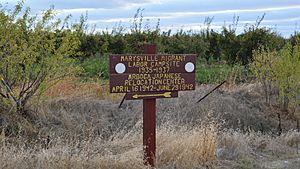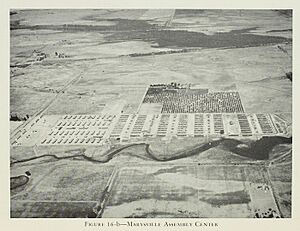Arboga, California facts for kids
Quick facts for kids
Arboga
|
|
|---|---|
| Country | United States |
| State | California |
| County | Yuba County |
| Elevation | 56 ft (17 m) |
Arboga is a small, unincorporated community in Yuba County, California. This means it's a place with people living there, but it doesn't have its own city government. It is located about 3 miles (5 km) south of Olivehurst. Arboga sits at an elevation of 56 feet (17 meters) above sea level.
The community got its name in 1911. A pastor from the Mission Covenant Church of Sweden named it after his hometown, Arboga, Sweden.
During World War II, a special camp was set up here. This camp was a temporary place where Japanese Americans were held. They were moved from their homes on the West Coast by a government order. This happened from May 8, 1942, to June 29, 1942. About 2,465 people were held at the camp. After this, they were moved to a more permanent camp called Tule Lake in California.
Arboga also had a post office for some years. It was open from 1912 to 1926.
The Marysville Assembly Center: A Wartime Story
The Marysville Assembly Center was built at a place that used to be a camp for migrant workers. It was located in Arboga, about 8 miles south of Marysville, California. People also called it the Arboga Assembly Center.
This center was one of fifteen temporary camps in California. People of Japanese ancestry were held here from May 8, 1942, to June 29, 1942. At its busiest time, the camp held 2,465 people. Most of these people came from Placer and Sacramento counties.
The camp had about 160 buildings. These included five dining halls and two places for medical care. Most of the people held here were later moved to the Tule Lake War Relocation Center. In July 1942, the US Army took over the camp for use by soldiers.
Today, the site of the Marysville Assembly Center is a California Historical Landmark. Its number is 934.01.
The California Historical Landmark sign explains:
- NO. 934 TEMPORARY DETENTION CAMPS FOR JAPANESE AMERICANS-MARYSVILLE ASSEMBLY CENTER - These temporary camps were the first step in holding 97,785 Californians of Japanese heritage during World War II. On February 19, 1942, President Franklin D. Roosevelt signed an order. Because of this order, thirteen temporary camps were built. They were set up at racetracks, fairgrounds, and labor camps in California. These places were meant to hold Japanese Americans until bigger, more permanent camps could be built. Some of these larger camps were Manzanar and Tule Lake in California. Starting on March 30, 1942, all Americans born in the U.S. and legal residents of Japanese heritage living in California were told to report for detention.
See also
 In Spanish: Arboga (California) para niños
In Spanish: Arboga (California) para niños





